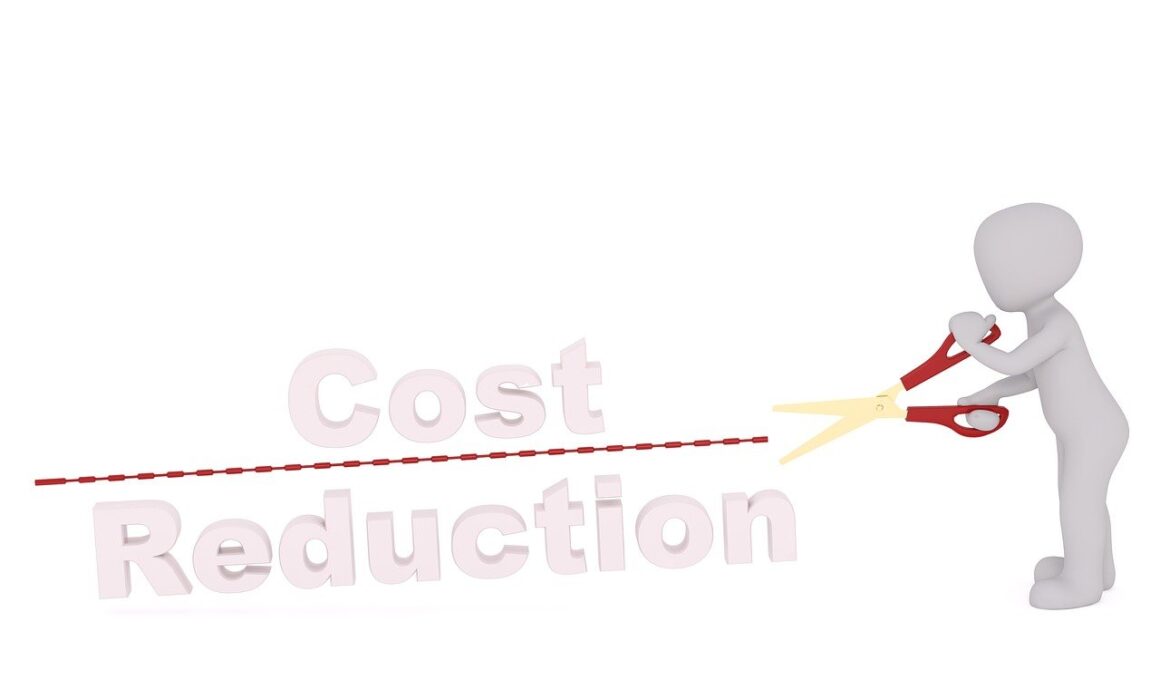Reducing Maintenance Costs Using Six Sigma Methodologies
In today’s competitive market, organizations are continuously striving to enhance productivity while minimizing expenses. A pivotal method for achieving this is through Six Sigma methodologies, which focus intensively on process improvement. By reducing defects and enhancing operational efficiencies, Six Sigma presents a structured approach for cost reduction efforts. Organizations can leverage the DMAIC framework (Define, Measure, Analyze, Improve, and Control) to streamline maintenance operations, resulting in substantial cost savings. Moreover, this systematic approach enables organizations to identify key areas where costs can be curtailed without compromising quality. For maintenance departments, applying Six Sigma can lead to more reliable equipment, thus extending lifecycle and reducing costs associated with repairs or replacements. With an empirical focus, companies can gather data-driven insights, leading to smarter decisions that promote maintenance efficiency. Therefore, embracing Six Sigma methodologies not only enhances maintenance strategies but significantly impacts the overall financial health of an organization. Ultimately, decreasing maintenance costs fosters improved profitability, allowing organizations to allocate resources more effectively, positioning themselves favorably in their respective industries.
Implementing Six Sigma initiatives in maintenance can markedly improve the effectiveness of operations. One of the key driving forces behind this improvement is defect reduction, which is fundamental to the Six Sigma philosophy. Regulations surrounding maintenance activities can often introduce inefficiencies, leading to unexpected downtimes and increased expenses. By employing the DMAIC approach, organizations can systematically eliminate these inefficiencies. First, it is essential to define expectations clearly. Next, measuring current performance helps identify specific areas where waste exists. Analyzing data to uncover root causes allows for targeted improvements. Then, through continuous improvements, teams can implement solutions to enhance workflows significantly. Lastly, controlling processes ensures that the improvements remain sustainable over time. This cycle encourages a culture of continuous improvement within maintenance teams. Furthermore, training employees in Six Sigma principles fosters a commitment to ongoing excellence in their roles. The experience gained through this structured approach equips maintenance teams with skills to analyze situations critically. Investing in Six Sigma training can yield a tremendous return on investment by systematically minimizing maintenance costs.
Motivating Factors for Cost Reduction
Several motivating factors necessitate the adoption of Six Sigma methodologies for cost reduction within maintenance operations. First and foremost, financial pressures are a significant driving force. Companies face constant pressure to enhance profit margins while managing operational expenditures effectively. Maintenance, often overlooked, presents a notable opportunity for cost savings. Improved processes not only lower direct maintenance costs but can also positively influence indirect costs, such as production downtime. Furthermore, regulatory compliance is an essential factor; organizations must comply with industry standards, leading to potential fines and operational disruptions. Efficient maintenance approaches reduce the risk associated with compliance failings. Additionally, the competitive landscape fuels the necessity for superior operational efficiency. Companies striving for market leadership cannot afford inefficiencies linked to high maintenance costs. Thus, adopting Six Sigma offers a strategic pathway to address these challenges. Embracing data-driven insights enables organizations to optimize their maintenance protocols, aligning them with strategic business objectives. The proactive nature of Six Sigma equips organizations to stay ahead of competition, ensuring sustainable operational practices.
Central to Six Sigma methodologies is the critical concept of employee engagement in maintenance operations. Employee involvement is instrumental in achieving desired outcomes, particularly when pursuing cost reductions. Employees possess firsthand knowledge about the processes they operate, making their insights valuable in identifying inefficiencies. Facilitating workshops or training sessions increases awareness about Six Sigma principles and encourages team members to seek out areas for improvement actively. Moreover, establishing cross-functional teams fosters collaboration, creating a platform where diverse perspectives come together. This integration enhances creativity, leading to innovative solutions for pain points identified during maintenance operations. Additionally, recognizing and rewarding employee contributions can foster a culture of accountability and ownership. Empowering employees to adopt a quality mindset significantly increases the likelihood of sustained improvements in processes. Reporting successes linked to Six Sigma implementations not only boosts morale but reinforces the idea that each member plays a crucial role in the organization’s overall efficacy. Ultimately, embracing employee engagement within such frameworks is foundational for operational excellence, leading to decreased maintenance costs while enhancing work culture.
Data-Driven Decisions and Maintenance Enhancements
Data-driven decision-making is fundamental in experimenting with Six Sigma methodologies to reduce maintenance costs. The collection and analysis of data provide insights that inform maintenance strategies while elucidating patterns affecting operational performance. For example, historical data on breakdowns helps maintainers anticipate potential failures and schedule preventive actions accordingly. By implementing statistical tools such as Pareto analysis, organizations can identify the most common issues that lead to machinery breakdowns. Addressing these high-frequency problems results in significant long-term savings. Moreover, ongoing data collection allows teams to monitor performance in real time, enabling swift responses to developing issues. This proactive approach minimizes unplanned downtimes that can escalate maintenance expenses dramatically. Predictive maintenance models supported by data analytics enhance the accuracy of maintenance forecasting, ensuring that resources are allocated efficiently. As a result, organizations can optimize staff and inventory levels, reducing excess costs while maintaining high operational standards. Consequently, incorporating data analytics holds the potential for fundamental improvements, empowering organizations to harness their maintenance capabilities robustly.
Another critical aspect of the Six Sigma approach is the emphasis on process standardization, which brings notable benefits in reducing maintenance costs. Inconsistent maintenance practices result in variability, leading to inefficiency and increased expenses. By standardizing processes, organizations can eliminate ambiguities that breed errors. This enhances predictability and reliability in maintenance actions, ensuring optimal resource utilization at every level. First, documenting maintenance protocols provides a consistent blueprint for employees to follow, enhancing performance across the board. Regular audits can also reinforce adherence to these established procedures. Furthermore, standardization translates into accelerated training for new employees, significantly reducing the learning curve associated with various tasks. Therefore, adopting clear, uniform processes results in proficiency that drives operational efficiency. Enhanced predictability also fosters better planning regarding inventories and staffing needs. Ultimately, these cost-effective strategies contribute to overall sustainability in maintenance practices. The correlation between standardization and enhanced efficiency results in greater flexibility, making organizations more responsive to emerging needs without incurring unnecessary costs. Hence, standardizing maintenance practices becomes an essential milestone for achieving lasting successes.
Measuring and Evaluating Six Sigma Initiatives
Measuring and evaluating the effectiveness of Six Sigma initiatives is paramount in realizing sustained cost reduction in maintenance processes. Organizations must establish clear metrics that reflect both financial and operational performances. Key Performance Indicators (KPIs) such as Mean Time to Repair (MTTR) and maintenance costs per unit produced offer critical insights into the maintenance efficiencies post-Six Sigma implementation. By consistently monitoring these KPIs, organizations can gauge the impact of their Six Sigma strategies on overall maintenance costs effectively. Furthermore, utilizing tools like value stream mapping allows teams to visualize process flows and pinpoint areas causing delays or inefficiencies. Engaging in this evaluation process fosters accountability across teams, providing a systematic framework for continuous improvement. Feedback loops facilitate learning opportunities, allowing organizations to adjust tactics as necessary to reinforce success. Additionally, stakeholders should be involved in these evaluations to align maintenance activities with broader business goals. By measuring and adjusting accordingly, organizations can assure that their Six Sigma methodologies translate into tangible and sustainable cost reductions, enhancing competitive positioning and operational discipline.
Ultimately, the successful integration of Six Sigma methodologies in maintenance operations paves the way for enhanced cost efficiency and organizational effectiveness. Organizations that embrace these strategies foster a culture of continuous improvement, ensuring that cost-cutting measures are implemented with precision. The focus on data-driven decisions, standardized practices, and employee engagement leads to a more streamlined approach. Additionally, through rigorous measurement and evaluation, organizations can sustain their improvements over time while adapting to changing market conditions. These efforts yield not only short-term savings but also long-term benefits, fostering resilience in operations. The ripple effects of reduced maintenance costs manifest across various functions, impacting productivity and profitability positively. Furthermore, the increased reliability of maintenance practices empowers organizations to focus on core business activities, driving further innovation and growth. As companies navigate the complexities of modern markets, adopting Six Sigma methodologies equips them with tools to remain competitive. Therefore, organizations keen on maintaining their market position should prioritize adopting such frameworks, ensuring they reap the extensive benefits of reduced maintenance costs, operational excellence, and empowered teams.


